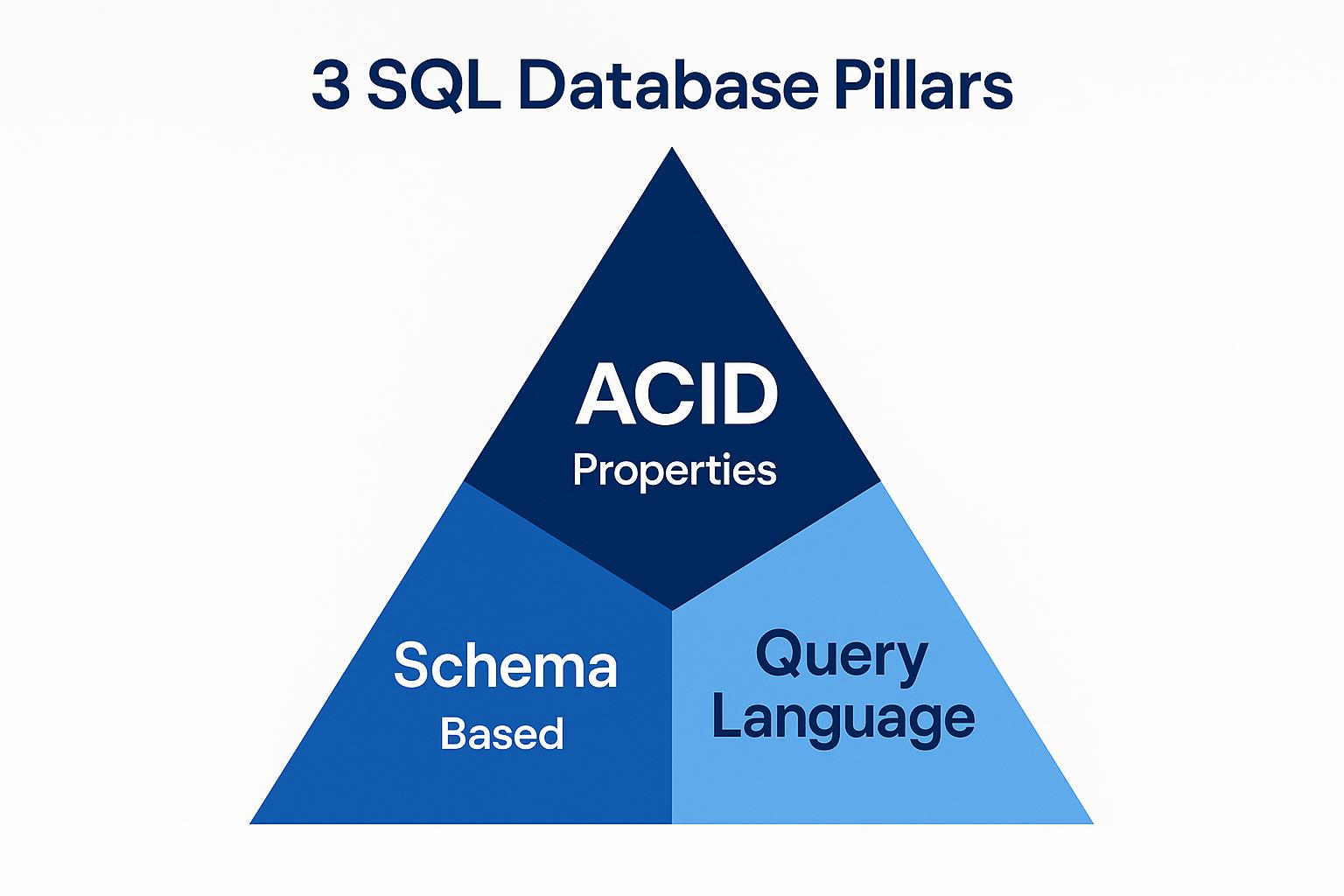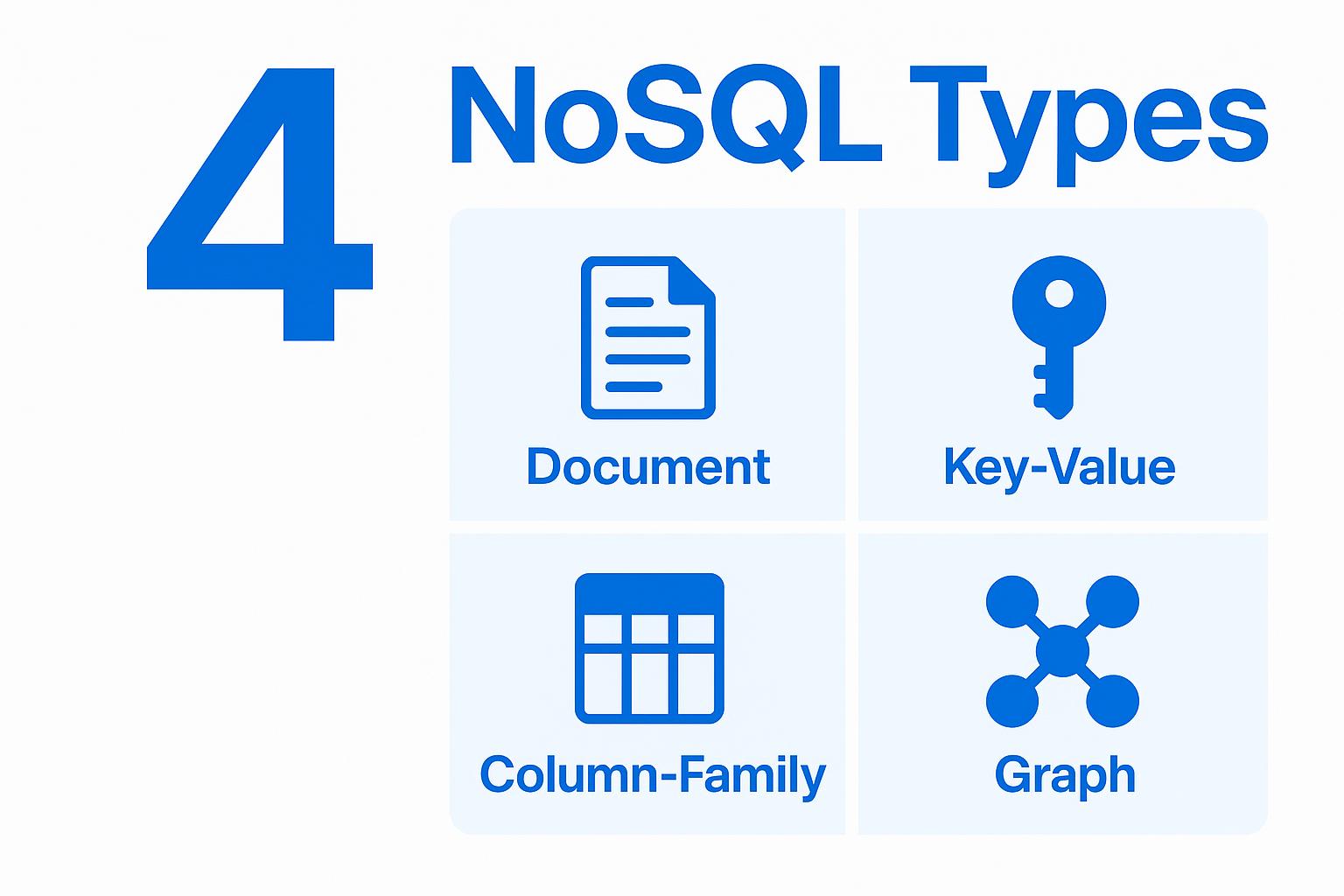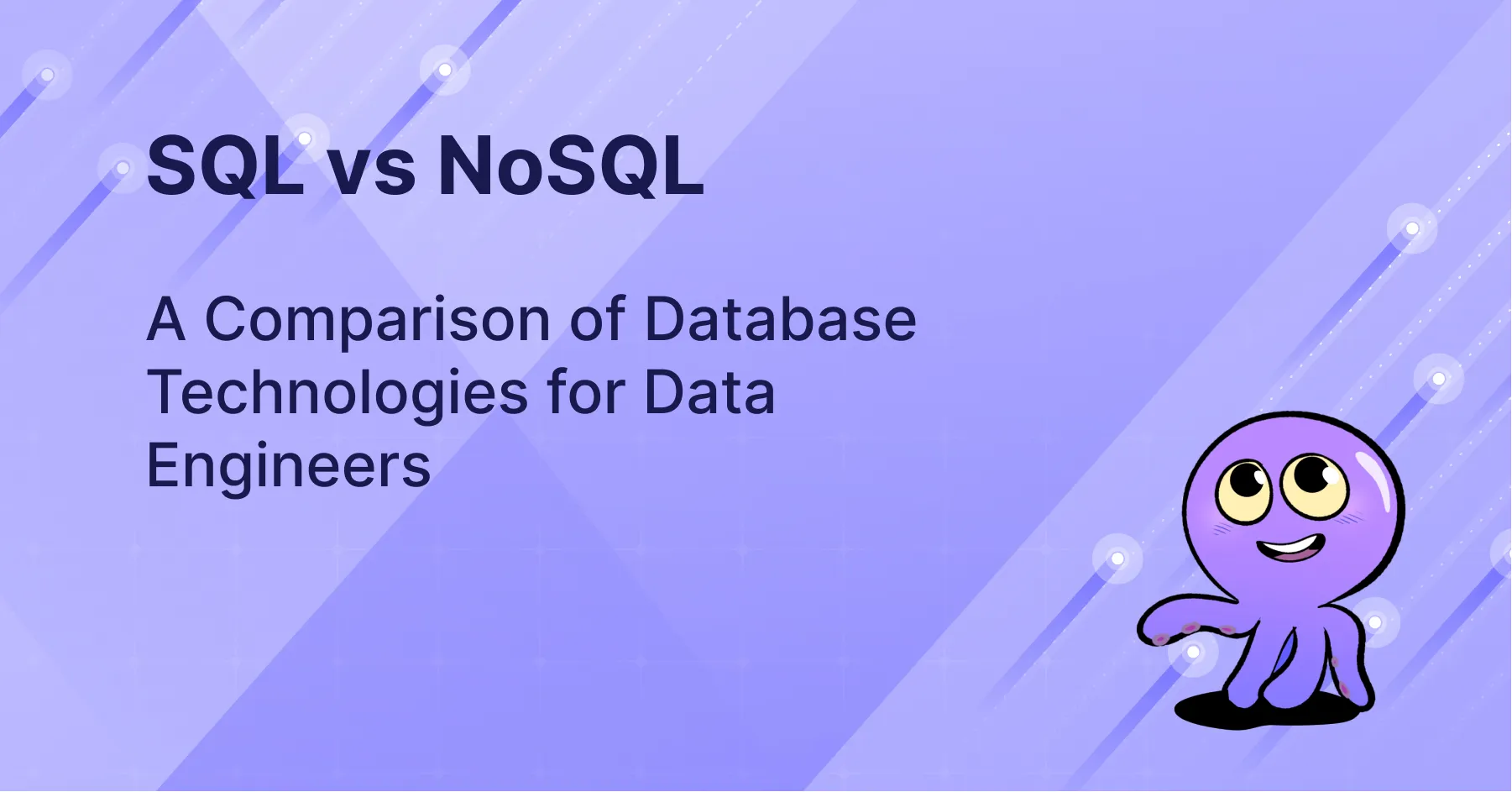SQL vs NoSQL: A Comparison of Database Technologies for Data Engineers
Summarize this article with:
✨ AI Generated Summary
SQL databases use structured schemas with ACID compliance, ideal for complex queries and transactional consistency, while NoSQL databases offer flexible, schema-less designs optimized for scalability and unstructured data. Hybrid architectures and NewSQL platforms combine strengths of both, enabling scalable, consistent, and versatile data management. AI and machine learning enhance database automation, security, and user interaction, while security strategies must address distinct vulnerabilities in SQL and NoSQL systems, especially in hybrid environments.
Most data engineers, analysts, and IT professionals are familiar with SQL (Structured Query Language) and relational database management systems (RDBMS). While this type of database has been a standard for decades, organizations need solutions that can handle unstructured data, varying data types, and modern use cases.
To support diverse use cases, data teams have turned to NoSQL databases, which use flexible schemas and have high availability. The sql vs nosql database decision is no longer binary—hybrid architectures, NewSQL platforms, and AI-enhanced systems are transforming how organizations approach data management.
In this article, we explain the key features of each database technology and compare SQL vs NoSQL databases in detail. We have also outlined the best scenarios to use each database type so you can make an informed decision about the right system.
What Are SQL Databases and Their Core Characteristics?
SQL (Structured Query Language) is a programming language used to manage and modify structured data in a relational database management system (RDBMS).
SQL is used to create, modify, and query relational databases that drive applications used in e-commerce platforms, financial management systems, healthcare solutions, and more.
Relational databases organize data in tables. Data engineers can define relationships between tables using primary and foreign keys. They can create views, indexes, and triggers for additional functionality.
SQL statements enable database operations, including creating tables, inserting, updating, and retrieving data. Relational databases can handle complex queries needed for data analytics and business intelligence.
Key Features

SQL databases have three key characteristics:
- ACID properties: SQL databases are ACID compliant.
- Schema-based data organization: Data is organized in relational tables.
- SQL as a query language: All SQL dialects share a common syntax and nearly identical grammar.
Popular SQL Databases
- MySQL: Open-source, fast, and scalable; widely used for web applications.
- PostgreSQL: Robust and flexible; supports advanced features like triggers and stored procedures.
- Microsoft SQL Server: Supports data integration, OLAP, OLTP, and reporting.
- Oracle Database: Enterprise-grade platform for transaction processing and in-memory workloads.
What Are NoSQL Databases and How Do They Differ from Traditional Systems?
NoSQL databases are non-relational databases used to store and manage unstructured and semi-structured data such as social-media posts, sensor data, and log files. They provide the flexibility and scalability needed to match the use cases of modern data teams.
These databases use flexible schemas for data storage and support varying data models—key-value, document, column-family, and graph—giving data engineers the freedom to design schemas and store different data structures within the same database.
Non-relational databases can support read-heavy and write-heavy workloads using distributed architectures and optimized data models. However, NoSQL languages lack the standard interface that SQL provides, so complex queries can be difficult to execute.
Key Features
- Schema-less data organization: Dynamic schemas enable rapid changes.
- Data-model flexibility: Key-value, document, column-family, and graph models.
- Scalability: Distributed architectures allow horizontal scaling by adding commodity servers, clusters, or nodes.
Types of NoSQL Databases

- Document Databases: Semi-structured (JSON or XML). Examples: MongoDB, Couchbase.
- Key-Value Databases: High-speed retrieval of small data amounts. Examples: Redis, Riak.
- Column-Family Databases: Fast retrieval of large datasets. Examples: Apache Cassandra, HBase.
- Graph Databases: Represent relationships as graphs. Examples: Neo4j, OrientDB.
What Are the Primary Advantages and Disadvantages of SQL vs NoSQL Databases?
SQL Databases
Pros
- ACID compliance ensures data validity and integrity.
- Strong consistency guarantees.
- Structured data is ideal for complex queries and relationships.
- Standardization—SQL is widely used and understood.
- Support for complex transactions across multiple tables.
Cons
- Horizontal scalability can be challenging.
- Rigid schema limits flexibility.
- Performance may degrade with very large datasets or complex queries.
- Higher costs for high-volume data or transaction workloads.
NoSQL Databases
Pros
- Designed for horizontal scaling and large data volumes.
- Schema-less design allows easy changes to data models.
- Can be faster for certain operations and large datasets.
- Well-suited for big-data and unstructured data.
- Can accelerate development speed.
Cons
- May sacrifice strong consistency for availability/partition tolerance.
- Lack of a standardized query language across systems.
- Limited support for JOINs and complex queries.
- Limited ACID-transaction support in some databases.
- Generally less mature than SQL databases, with fewer tools and resources.
What Are the Key Technical Differences Between SQL and NoSQL Database Technologies?
Below are five key differences:
Data Modeling and Structure
- SQL: Structured data in tables with fixed schemas; relationships defined by keys; data normalized to avoid duplication.
- NoSQL: Flexible data models (key-value, document, column-family, graph) for semi-structured and unstructured data.
Query Language and Operations
- SQL: Standardized query language (
SELECT,INSERT,UPDATE,DELETE, joins, aggregates, subqueries). - NoSQL: Query languages vary by database type; many provide APIs for custom queries in languages like JavaScript or Python.
Scalability
- SQL: Primarily vertical scaling; horizontal scaling possible but complex.
- NoSQL: Built for horizontal scaling with automatic load balancing.
Consistency and Transactions
- SQL: Fully ACID-compliant.
- NoSQL: Consistency models vary; many provide eventual consistency, though some now support ACID transactions.
Ecosystem and Community
- SQL: Decades-old, mature tooling, large community.
- NoSQL: Newer, rapidly evolving ecosystem, active communities for specific systems.
Performance
- SQL: Excels at complex, multi-table queries but may slow with massive datasets or high write loads.
- NoSQL: Optimized for high-performance operations on large volumes, particularly for simple queries on unstructured data.
What Are Hybrid Database Architectures and How Do They Work?
The evolution of database technology has moved beyond the traditional SQL vs NoSQL debate toward sophisticated hybrid architectures that combine the strengths of both approaches. These architectures address the reality that modern applications require different data management strategies for different types of workloads and data structures.
NewSQL: Bridging the Gap Between SQL and NoSQL
NewSQL databases represent a revolutionary approach that combines SQL's ACID compliance with NoSQL's horizontal scalability. Systems like Google Spanner, CockroachDB, and VoltDB enable distributed SQL processing across multiple nodes while maintaining strong consistency guarantees.
NewSQL architectures achieve this through innovative approaches like distributed consensus protocols, automated sharding, and clock synchronization. These systems allow you to execute complex SQL queries across globally distributed data while maintaining the transactional integrity that traditional SQL databases provide.
Polyglot Persistence and Multi-Model Databases
Polyglot persistence represents a strategic approach where different database technologies are deployed within the same application architecture to handle specific data types and access patterns optimally. Rather than forcing all data into a single database model, you can choose the best tool for each specific use case.
Multi-model databases take this concept further by providing multiple data models within a single database system. Azure Cosmos DB, for instance, supports document, key-value, graph, and column-family models through different APIs, allowing you to work with diverse data types without managing multiple database systems.
How Are AI and Machine Learning Transforming Database Management?
Artificial intelligence and machine learning are fundamentally reshaping how databases operate, from query optimization to autonomous management. These technologies are making database systems more intelligent, self-managing, and accessible to users with varying technical backgrounds.
Natural Language Processing for Database Interaction
Natural language processing (NLP) capabilities are revolutionizing how users interact with databases. Modern AI-powered tools can translate natural language queries into optimized SQL or NoSQL operations, making database access more intuitive for business users and analysts.
These systems understand context and intent, enabling users to ask complex questions in plain English rather than requiring deep SQL knowledge. For example, a user might ask "show me the top-performing products from last quarter" and receive properly formatted queries that join multiple tables and apply appropriate filters.
Autonomous Database Optimization and Management
Machine learning algorithms are enabling databases to become self-optimizing and self-managing. These systems continuously monitor query patterns, resource utilization, and performance metrics to automatically adjust configurations, create indexes, and optimize query execution plans.
Autonomous optimization goes beyond traditional rule-based approaches by learning from historical patterns and predicting future needs. Database systems can now anticipate workload changes, pre-emptively scale resources, and identify potential performance bottlenecks before they impact users.
AI-Enhanced Security and Compliance
Machine learning models are transforming database security by enabling real-time threat detection and automated compliance management. These systems can identify unusual query patterns, detect potential security breaches, and automatically implement protective measures.
AI-powered security systems learn normal user behavior patterns and flag anomalous activities that might indicate unauthorized access or data exfiltration attempts. This behavioral analysis provides more sophisticated protection than traditional rule-based security measures.
How Do Security and Compliance Considerations Influence SQL vs NoSQL Database Selection?
SQL Database Security Enhancements
Granular role-based access control, transparent data encryption, row-level security, dynamic data masking, and integration with enterprise identity management systems help SQL databases meet stringent regulations like HIPAA and GDPR.
Modern SQL databases provide comprehensive audit trails, automated compliance reporting, and fine-grained permission controls that make them well-suited for highly regulated industries. The mature security ecosystem around SQL databases includes extensive tooling for monitoring, threat detection, and compliance management.
NoSQL Security and Governance
NoSQL platforms have advanced rapidly, offering client-side encryption, audit logging, and integration with cloud KMS solutions to satisfy data sovereignty and compliance requirements. Modern NoSQL systems provide sophisticated authentication and authorization mechanisms that rival traditional SQL databases.
Distributed NoSQL systems present unique security challenges around data consistency and access control across multiple nodes. However, recent advances in distributed security protocols and consensus mechanisms have significantly improved the security posture of NoSQL deployments.
Compliance Automation and Governance
Modern platforms automate evidence collection and offer pre-configured compliance mappings for various regulatory frameworks. This automation reduces the burden of compliance management while ensuring consistent adherence to security policies.
Data lineage tracking and automated policy enforcement help organizations maintain compliance across complex data processing pipelines. These capabilities are particularly important as data moves between different database systems in hybrid architectures.
How Do Security Vulnerabilities Differ Between SQL and NoSQL Databases?
Database security extends beyond traditional concerns like access control and encryption to include specific vulnerability patterns unique to each database paradigm. Understanding these distinct security challenges is crucial for implementing effective defense strategies across hybrid database environments.
NoSQL Injection Attack Mechanisms
NoSQL injection attacks represent a significant yet underaddressed security concern that differs fundamentally from traditional SQL injection. While SQL injection exploits string-based query construction, NoSQL injection attacks manipulate the flexible query structures and operators inherent in NoSQL systems.
MongoDB, for example, is vulnerable to operator injection where attackers submit malicious operators as query parameters. Consider an authentication query that accepts user input directly into a MongoDB find operation. An attacker could submit {"$ne": null} for both username and password fields, causing the query to return the first user record where both fields are not null, effectively bypassing authentication controls.
JavaScript execution vulnerabilities in NoSQL systems pose additional risks. Databases like MongoDB that support JavaScript evaluation through $where clauses can be exploited to execute arbitrary code on the database server. Attackers can inject JavaScript functions that perform denial-of-service attacks, access system resources, or extract sensitive data through server-side execution.
Document-based NoSQL systems face schema manipulation attacks where malicious input attempts to inject unexpected fields or nested structures. These attacks can bypass application-level validation by exploiting the flexible schema nature of document databases, potentially leading to privilege escalation or data corruption.
NoSQL-Specific Defense Strategies
Input validation for NoSQL databases requires different approaches than SQL systems. Rather than focusing solely on string sanitization, you need to validate data types and restrict operator usage. Implement strict type checking that ensures query parameters match expected data types before database execution.
Operator whitelisting provides effective protection against NoSQL injection by explicitly defining allowed query operators and rejecting any operations outside the approved list. Most applications only require basic query operators like equality and range comparisons, making operator restriction a practical defense mechanism.
Parameterized queries and prepared statements, while common in SQL databases, require careful implementation in NoSQL systems. Some NoSQL databases support parameterized queries through driver-level features, but you must ensure that parameter binding occurs at the database level rather than through simple string substitution.
Authentication and authorization controls need special attention in distributed NoSQL deployments. Role-based access control should restrict not only data access but also the types of operations and query operators available to different user roles. Administrative operations like $where clauses should be completely disabled for application-level database users.
Advanced Security Considerations for Hybrid Environments
Cross-database security policies become complex when SQL and NoSQL systems interact within the same application. Data that moves between systems through integration pipelines may face different validation rules and security controls, creating potential vulnerability gaps at system boundaries.
API security layers provide unified protection for hybrid database environments by implementing consistent validation and sanitization regardless of the underlying database technology. These layers can enforce security policies that translate between SQL and NoSQL security models while maintaining application functionality.
Real-time threat detection systems must understand the different attack patterns associated with each database type. Traditional SQL injection detection tools may not identify NoSQL injection attempts, requiring specialized monitoring that can recognize operator injection and JavaScript-based attacks specific to NoSQL systems.
Secure development practices need adaptation for NoSQL environments. Code review processes should include checks for direct operator usage, JavaScript evaluation, and flexible schema handling. Developer training must cover both SQL and NoSQL security patterns to ensure comprehensive security awareness across hybrid development teams.
What Are the Optimal Use Cases and Selection Criteria for SQL vs NoSQL Databases?
When to Choose SQL Databases
Complex transactions and queries requiring joins and aggregations make SQL databases the optimal choice. The standardized query language and mature ecosystem provide broad compatibility with existing tools and skills.
Financial applications, healthcare systems, and other domains requiring strict consistency and data integrity benefit from SQL's ACID compliance and robust transaction support. The well-established patterns for backup, recovery, and high availability make SQL databases reliable for mission-critical applications.
SQL databases excel in scenarios where data relationships are complex and well-defined, such as enterprise resource planning systems, customer relationship management platforms, and traditional business applications.
When to Choose NoSQL Databases
High scalability requirements and large volumes of unstructured or semi-structured data make NoSQL databases the preferred choice. The flexible schema design accommodates rapidly changing data structures and varying data types.
Real-time applications, content management systems, and big-data analytics benefit from NoSQL's horizontal scaling capabilities and optimized performance for specific access patterns. The ability to handle diverse data models within a single system simplifies architecture for complex applications.
NoSQL databases are particularly well-suited for modern web applications, mobile backends, and IoT data processing, where scalability and flexibility are more important than complex relational queries.
Hybrid Decision Framework
The choice between SQL and NoSQL often depends on specific workload characteristics rather than broad application categories. Consider data volume, query complexity, consistency requirements, and scalability needs when making technology decisions.
Many successful applications use both SQL and NoSQL databases in different parts of their architecture, leveraging the strengths of each approach where they provide the most value. This polyglot persistence approach allows you to optimize for specific use cases while maintaining overall system coherence.
Benefits of hybrid approaches include:
- Improved performance through optimized data placement and caching strategies.
- Enhanced flexibility to choose the optimal storage and processing approach for each data type.
- Better scalability at lower cost by using horizontal scaling where appropriate.
- Risk mitigation through technology diversification and reduced vendor lock-in.
Conclusion
The choice between SQL and NoSQL databases depends on specific workload requirements rather than an either-or decision. Modern database architectures increasingly combine the strengths of both paradigms through hybrid approaches, NewSQL systems, and multi-model databases. Organizations should evaluate their data structure, consistency requirements, and scalability needs to select the optimal database technology for each specific use case.
Frequently Asked Questions
Is SQL or NoSQL better for modern applications?
SQL is best for structured data, strong consistency, and complex transactions, while NoSQL excels with unstructured data, high throughput, and flexible schemas. Modern applications often combine both, using a hybrid approach tailored to specific workloads.
What are the main technical differences between SQL and NoSQL?
SQL databases are relational with fixed schemas, ACID compliance, and complex joins, typically scaling vertically. NoSQL databases are non-relational, schema-less, horizontally scalable, often eventually consistent, and use varied data models with custom query interfaces.
When should I consider a hybrid or multi-model database strategy?
Consider hybrid or multi-model databases when applications need diverse data types or workloads. Hybrid setups combine specialized databases (e.g., PostgreSQL, MongoDB, Redis, Neo4j) or platforms like Cosmos DB to optimize performance, flexibility, and cost without limiting to one model.
How are AI and machine learning changing database management?
AI and ML transform databases by enabling self-optimization, automated index tuning, resource allocation, natural language querying, anomaly detection, and predictive security, reducing manual intervention and making databases more adaptive, intelligent, and self-managing.
What are the observability challenges in SQL vs NoSQL systems?
SQL systems offer mature monitoring with predictable schemas, but NoSQL’s distributed, flexible nature demands specialized tools for tracking consistency lag, latency, and partitioning. Hybrid setups require cross-system metrics, distributed tracing, and anomaly detection to ensure full observability.

.webp)
